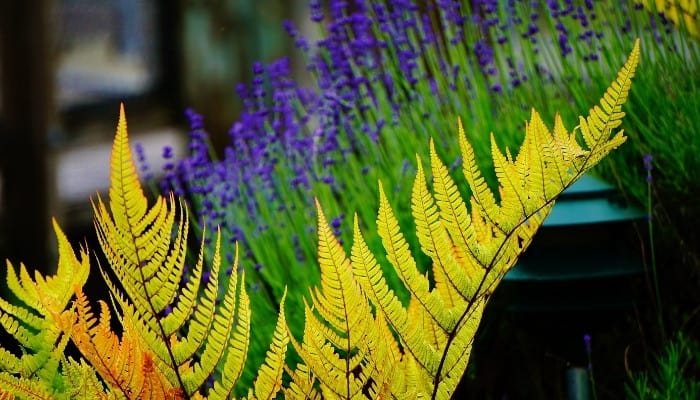Selecting suitable companion plants for ferns can be challenging due to their preference for shade.
In addition, most ferns originate from warm, tropical areas and are used to high humidity levels and rain. Generally, ferns prefer a shady spot with moist, well-draining soil.
While you may be looking for a glorious garden display, you also need to be sure that you choose companion plants that grow well in similar growing conditions.
Therefore, selecting the correct companion plants for your ferns is imperative if you want your ferns to remain healthy and frond-a-licious.
1. Coral Bells
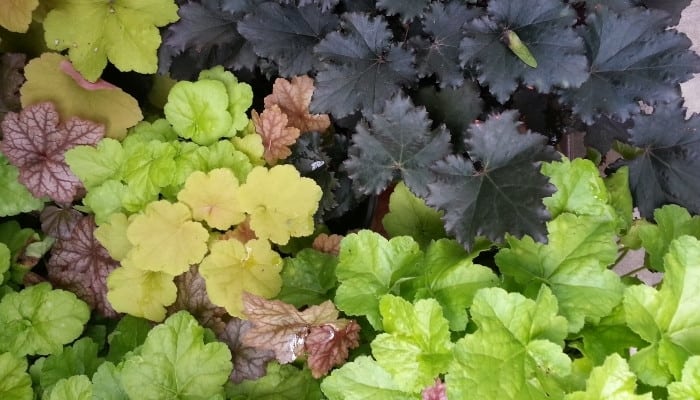
Coral Bells (Heuchera sanguinea) produce vibrant foliage in colors ranging from greens to purples, pinks, and bronze.
Like ferns, coral bells keep their leaves all year round, producing tiny white, red, or pink flowers in the summer.
Coral bells do well when grown in partial shade with access to moisture-rich soil, making them a great companion for the shade-loving ferns in your garden.
- Average size: Height 12 inches, width 20-21 inches
- Colors: Purple, green, gray, pink, bronze
- Light requirements: Partial shade
- Popular varieties: Heuchera ‘Walnut’, Heuchera ‘Green Spice’, Heuchera ‘Blondie’
2. Astilbes
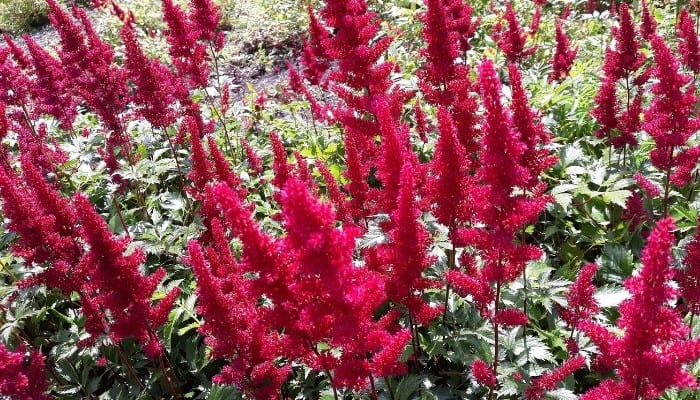
Astilbes are the perfect fern companion, producing similar fern-like foliage and feathery flower plumes in the summer.
They are also known as False Goat’s Beard or False Spirea and enjoy the shady, moist areas of the garden and therefore grow well when paired with ferns.
However, they may require a little extra water as they can be thirsty plants.
- Average size: Height 4 feet
- Colors: Cream, pink, purple, and bright red
- Light requirements: Partial shade
- Popular varieties: Chinese astilbe, Japanese astilbe, Star astilbe
3. Forget-Me-Nots

Forget-me-nots (Myotis scorpioides) are moisture-loving plants that enjoy a similar growing environment to ferns.
In nature, they can often be found growing near bodies of water where humidity and water levels are high.
They produce blue flowers with yellow centers on top of long, hairy stems in the summer.
- Average size: Height 24 inches
- Colors: Blue, pink, purple, and white with yellow centers
- Light requirements: Shade
- Popular varieties: Wood Forget-me-not, Water Forget-me-not
4. Sedges
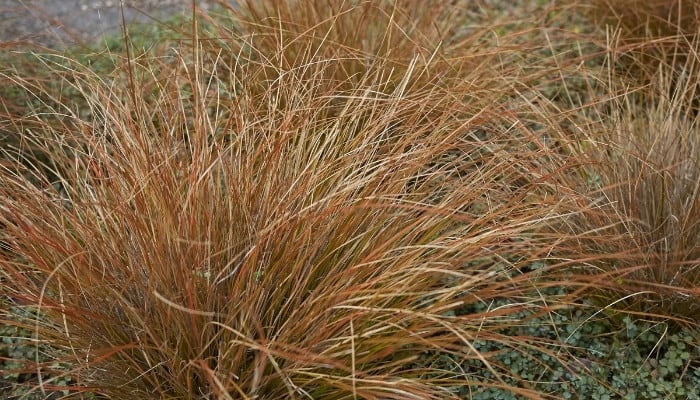
There are more than 1,500 species of sedge plants. They are also known as graminoids because of their grass-like appearance.
These plants are excellent companion plants for ferns due to their love of damp, shady areas in the garden.
Often grown as an ornamental grass in containers or borders, they add character to shady fern gardens.
- Average size: Varies significantly depending on variety
- Colors: Green, brown, blue, lime, bronze, orange, green/white-edged
- Light requirements: Partial shade to full sun
- Popular varieties: Leatherleaf Sedge, Variegated Japanese Sedge, Blue Sedge
5. Hostas
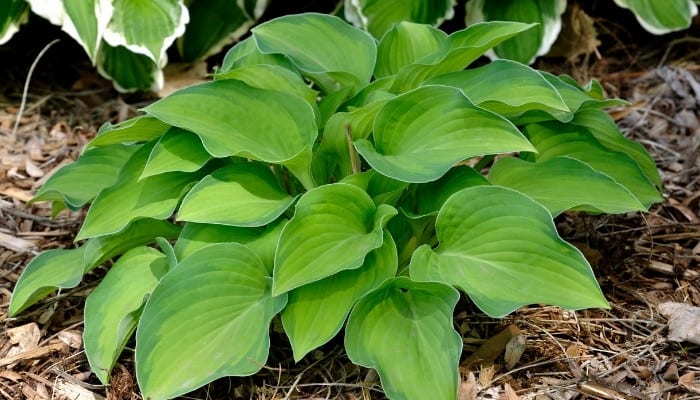
Hostas are shade- and moisture-loving plants that produce gorgeous foliage in various shades of green, blue, and yellow. White or purple flowers are displayed in the summer months.
Feathery fern foliage looks fantastic paired with the broad leaves of the hosta.
- Average size: Height 12-16 inches
- Colors: Green, blue, yellow
- Light requirements: Partial shade
- Popular varieties: August Moon, Blue Mouse Ears, First Frost, Gold Standard
6. Azaleas
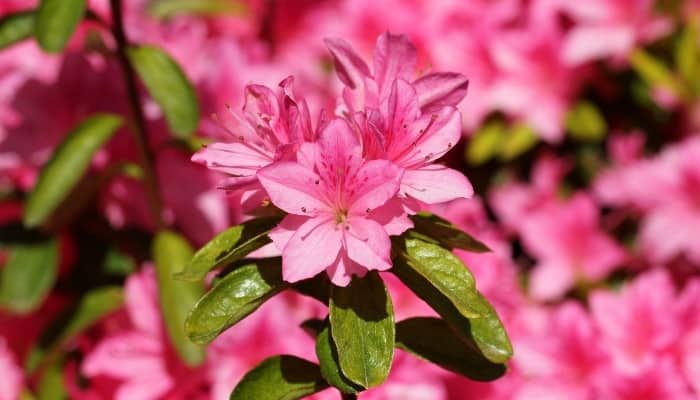
This flowering shrub prefers to grow in the shade of taller plants and trees and even beside ferns. Its soil preferences are similar to ferns, preferring moist, well-draining soil types.
There are many cultivars to choose from, ranging from pink to red, orange, and yellow.
- Average size: 12 inches to 10 feet depending on the variety
- Colors: Purple, pink, orange, yellow, red
- Light requirements: Partial shade
- Popular varieties: Northern Hi-lights, Encore Autumn Amethyst, Mandarin Lights
7. Caladiums
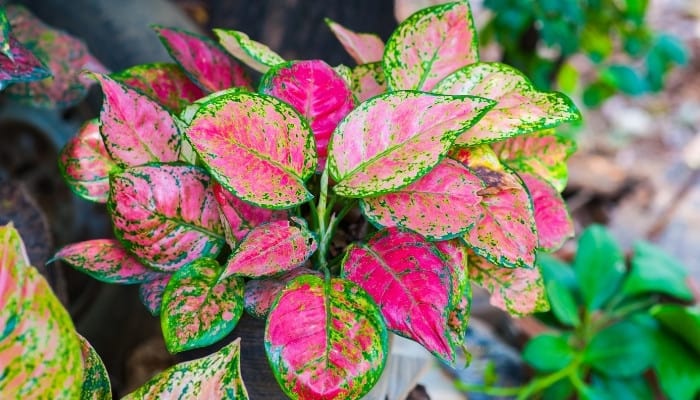
The tropical caladium or elephant ear grows well in shady areas of the garden. They prefer moisture-rich soil and can easily brighten a dim corner with their exotic heart-shaped foliage.
In addition, their moisture-loving tendencies and low-light requirements make them excellent companion plants for ferns.
- Average size: Height 14-30 inches, width 12-24 inches
- Colors: Red, white, pink, green
- Light requirements: Dappled light / partial shade
- Popular varieties: Caladium ‘Creamsicle’, Caladium ‘White Christmas’, Caladium ‘Miss Muffet’
8. Bleeding Hearts

The delicate bleeding heart (Lamprocapnos spectabilis) has heart-shaped blooms that hang from thin stems. The plant grows from an underground rhizome, much like the fern.
It enjoys the same growing conditions as the fern, preferring moist soil and partial to deep shade.
- Average size: Height 6 inches – 2 feet, width 15 feet
- Colors: Yellow, red, white, pink
- Light requirements: Partial/deep shade
- Popular varieties: King of Hearts, Alba, Pearl Drops, Burning Hearts
9. Galium
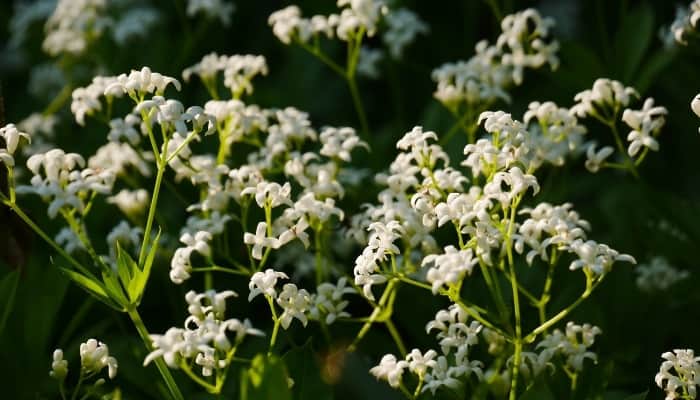
Galium is a hardy perennial ground cover that grows well in shaded areas. Also known as sweet woodruff, this sweetly scented plant produces tiny white flowers in the spring and summer.
It grows well in the same growing conditions as many ferns and thrives even in full shade.
- Average size: Height 12 inches
- Colors: White
- Light requirements: Partial/full shade
- Popular varieties: Galium odoratum
10. Brunnera

The low-growing brunnera perennial is another shade-loving plant species. It has heart-shaped leaves with distinctive veining and produces delicate sprays of blue or white flowers.
In addition, brunneras enjoy a cool, shady spot with moist to dry soil, making them an excellent addition to your fern garden.
- Average size: Height 18 inches, width 24 inches
- Colors: Blue, white
- Light requirements: Partial shade
- Popular varieties: Betty Bowring, Diane’s Gold, Jacks Gold
11. Hellebore
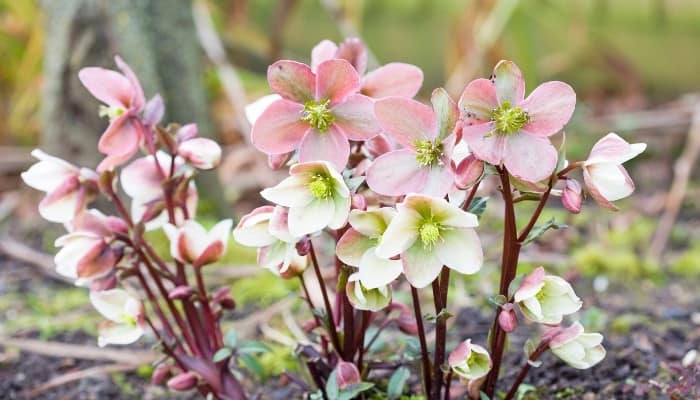
The hellebore is a super shade-loving plant that produces pretty rose-like blooms in winter and spring. These hardy, low-maintenance plants prefer moist soil that does not become waterlogged.
The best ferns to plant with Hellebore are evergreen ferns such as Hart’s tongue fern, Japanese tassel fern, and Christmas fern.
- Average size: Height 1 foot, width 3 feet
- Colors: Purple, white, yellow, pink
- Light requirements: Dappled/full shade
- Popular varieties: Christmas rose, Lenten rose, Stinking Hellebore
12. Corydalis

Corydalis plants prefer a shady spot in the garden and even do well in full shade.
Its preferred growing environment of shade and moist soil make this plant the perfect perennial to plant in your fern garden.
This relation of the poppy family produces small trumpet-shaped flowers in various shades of blue and purple, adding the perfect splash of color to a dim or shady garden corner.
- Average size: Height 12 inches
- Colors: Blue, blue-purple, white, yellow
- Light requirements: Partial shade
- Popular varieties: Corydalis ambigua, Corydalis angustifolia, Corydalis buschii
13. Spiderwort

The fuss-free spiderwort plant is an excellent choice for edging or shady beds in the garden. Its growth requirements are similar to the fern, requiring moist soil and partial shade.
It can also tolerate a range of soil pH levels, making it the least fussy fern companion you could choose to grow.
- Average size: Height 6 inches – 2 feet, width 1-1.5 feet
- Colors: Purple, Pink, Blue
- Light requirements: Partial shade
- Popular varieties: Amethyst Kiss, Concord Grape, Sweet Kate, Red Grape
14. Ligularia
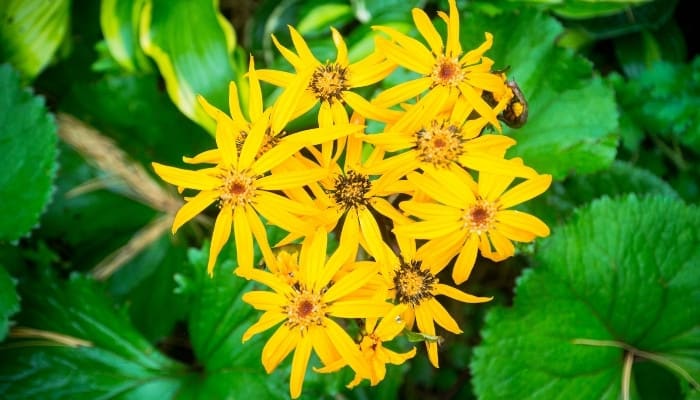
Ligularia dentata, also known as the leopard plant, is a shade-loving plant that produces brilliant orange-yellow flowers in the summer and autumn.
It can grow in a range of soils from clay to chalk and sand as long as it is moist and drains well. They provide a striking foliage backdrop in shady fern gardens.
- Average size: Height 47 inches
- Colors: Orange-yellow
- Light requirements: Dappled shade / full sun
- Popular varieties: Brit-Marie Crawford, Desdemona, Othello
15. Lily of the Valley
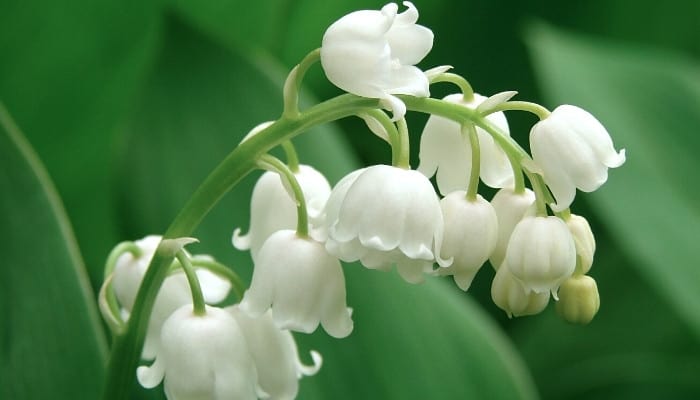
Lily of the valley plants grow from an underground rhizome like the fern. They grow well in moist soil but can adapt to drier environments.
They also flourish in full shade or sun and do well in partial shade. Its highly adaptable growing characteristics make this an easy plant to grow alongside many types of ferns.
- Average size: Height 8 inches
- Colors: White
- Light requirements: Full shade, partial shade, full sun
- Popular varieties: Convallaria majalis ‘Albostriata’, ‘Aureomarginata’
16. Other Ferns

Many types of ferns grow well together because they require a similar environment to grow. Most ferns prefer moist, well-draining soil and shady conditions.
However, some ferns are partial to a bit more sun than others, while others prefer drier soil.
For example, shade-loving ferns like the ‘Hard Fern’ or ‘Shuttlecock Fern’ are commonly known as woodland ferns and do best grown in moist soil; however, they can tolerate sun and drought conditions once established.
- Average size: Varies according to variety
- Colors: Green, pale green
- Light requirements: Dappled shade, partial shade, full shade
- Popular varieties: Hard Fern Blechnum spicant, Shuttlecock Fern Matteuccia struthiopteris
Conclusion
While some ferns can be a little picky when it comes to growing conditions, there is a whole range of hardy ferns that are easy to grow.
So if you have a shady spot in the garden in need of a little tropical pazazz, then a fern garden is undoubtedly a good option!
Paired with the perfect companion plant, the fronds of ferns will be accentuated and create a striking focal point in any shady garden.
Companion plants also help to create the additional shade that ferns crave.

